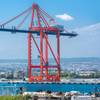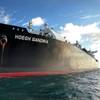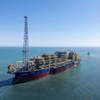In a report issued by the National Transportation Safety Board determined that insufficient intact stability and overloading caused the small passenger pontoon-style vessel, Lady D, to capsize when it encountered strong winds and waves in Baltimore's Northwest Harbor.
The accident occurred on the afternoon of March 6, 2004 as the vessel, carrying twenty-three passengers and two crewmembers, was en route from Fort McHenry to Fells Point, Maryland. Five passengers were killed and four suffered serious injuries. "This tragic accident happened as a result of a number of safety issues that fell through the cracks,"
stated NTSB Acting Chairman Mark V. Rosenker, "Our recommendations will go a long way toward fixing those cracks and help ensure this type of accident does not happen again."
The lack of intact stability was the result of overloading allowed by a U.S. Coast Guard Certificate of Inspection that was based on an inappropriate stability test done on a different pontoon vessel to which the Lady D was erroneously granted sister status. The Board also noted that the Coast Guard's regulatory stability test standards used an out-of- date average passenger weight standard that contributed to the overloading condition.
As a result the Board recommended that the Coast Guard revise their regulations to require that passenger capacity for domestic passenger vessels be calculated based on a statistically representative average passenger weight that is periodically updated. The Board further recommended that the Coast Guard identify a method for verifying safe loading on a small passenger vessel, such as a mark on the hull, and require that vessel owners implement that method.
The report also concluded that existing Coast Guard intact stability standards do not adequately account for the dynamic loading from wind and waves on a pontoon vessel operating on an unrestricted protected route. At the time of the capsizing, the Lady D encountered westerly winds gusting about 28 knots to 41 knots with a sustained wind speed of about 25 knots. The Board recommended that the Coast Guard revise stability criteria for pontoon type small passenger vessels to minimize the potential for capsizing in wind and waves.
The Board's investigation further determined that the National Weather Service (NWS) failed to identify the developing storm conditions in a timely manner, and therefore the weather information available to Seaport Taxi did not accurately reflect the impending storm conditions.
Additionally, Seaport Taxi's weather policy did not ensure maximum safety of operations during threatening conditions.
Since the time of the accident, the NWS conducted a study of their operational procedures and determined that forecasters needed a more aggressive and efficient approach in analyzing evolving weather conditions. The NWS has developed training exercises for the Baltimore-Washington weather forecast. The training exercises will be disseminated to all regions and specifically to offices with marine forecast responsibilities. The Board concluded that actions taken by the NWS are sufficient to address the weather forecasting problems that occurred in this accident.
Although Seaport Taxi no longer operates water taxi vessels in Baltimore harbor, after the accident and before ceasing operations, the company did revise its weather operating policy to establish specific wind and sea restrictions on their vessels. In addition the Board recommended that the Coast Guard establish limiting environmental conditions, such as weather, in which pontoon vessels may operate.












